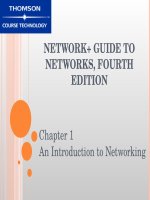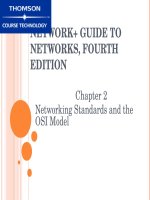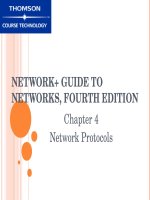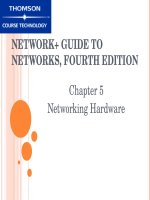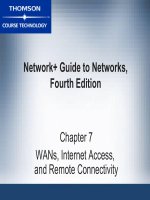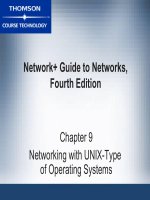NETWORK+ GUIDE TO NETWORKS, FOURTH EDITION - CHAPTER 12 ppt
Bạn đang xem bản rút gọn của tài liệu. Xem và tải ngay bản đầy đủ của tài liệu tại đây (577.91 KB, 55 trang )
Network+ Guide to Networks,
Fourth Edition
Chapter 12
Troubleshooting Network Problems
Network+ Guide to Networks, 4E 2
Objectives
•
Describe the steps involved in an effective
troubleshooting methodology
•
Follow a systematic troubleshooting process to
identify and resolve networking problems
•
Document symptoms, solutions, and results when
troubleshooting network problems
•
Use a variety of software and hardware tools to
diagnose problems
Network+ Guide to Networks, 4E 3
Troubleshooting Methodology
•
Steps for troubleshooting network problems:
–
Identify symptoms and potential causes
–
Identify affected area
–
Establish what has changed
–
Select most probable cause
•
Verify user competency
•
Re-create problem
•
Verify physical integrity of network connection
•
Verify logical integrity of network connection
Network+ Guide to Networks, 4E 4
Troubleshooting Methodology
(continued)
•
Steps for troubleshooting network problems
(continued):
–
Implement an action plan and solution and be
prepared for all potential effects
–
Test the result
–
Identify results and effects of solution
–
Document solution and process
Network+ Guide to Networks, 4E 5
Identify the Symptoms and Potential
Causes
•
Questions that may help identify non-obvious
symptoms:
–
Access to network affected?
–
Network performance affected?
–
Data and/or programs affected?
–
Only certain network services affected?
–
Problems include local application, networked
application, or multiple networked applications?
–
Specific error messages reported?
–
One user or multiple users affected?
–
Symptoms manifested consistently?
Network+ Guide to Networks, 4E 6
Identify the Affected Area
Figure 12-1: Identifying the area affected by a problem
Network+ Guide to Networks, 4E 7
Identify the Affected Area (continued)
Figure 12-1 (continued): Identifying the area affected by a
problem
Network+ Guide to Networks, 4E 8
Identify the Affected Area (continued)
Figure 12-2: Identifying the chronological scope of a problem
Network+ Guide to Networks, 4E 9
Identify the Affected Area (continued)
Figure 12-2 (continued): Identifying the chronological scope of a
problem
Network+ Guide to Networks, 4E 10
Establish What Has Changed
•
Questions to help pinpoint problems resulting from
a network change:
–
OS or configuration on a server, workstation, or
connectivity device changed?
–
New components added to server, workstation, or
connectivity device?
–
Old components removed from server, workstation,
or connectivity device?
–
New users or segments added to the network?
–
Server, workstation, or connectivity device moved
from previous location to new location?
Network+ Guide to Networks, 4E 11
Establish What Has Changed
(continued)
•
Questions to help pinpoint problems resulting from
a network change (continued):
–
Was a server, workstation, or connectivity device
replaced?
–
Was new software installed on a server, workstation,
or connectivity device?
–
Was old software removed from a server,
workstation, or connectivity device?
Network+ Guide to Networks, 4E 12
Establish What Has Changed
(continued)
•
Two ways to react to problems caused by network
changes:
–
Attempt to correct problem
–
Attempt to reverse change and restore hardware or
software to previous state
•
Complete network change records should be kept
–
Make available to staff members
Network+ Guide to Networks, 4E 13
Select the Most Probable Cause:
Verify User Competency
•
Ensure that human error is not source of problem
•
Problems caused by human error usually simple to
solve
•
Best way to verify that a user is performing network
tasks correctly is to watch them
Network+ Guide to Networks, 4E 14
Re-create the Problem
•
Try to reproduce symptoms both while logged on
as the user who reported the problem and while
logged on under a privileged account
•
Questions to help determine whether a problem’s
symptoms are truly reproducible:
–
Make symptoms recur every time?
–
Make symptoms recur some of the time?
–
Symptoms happen only under certain
circumstances?
–
Symptoms consistent no matter how many and
which programs or files user has open?
Network+ Guide to Networks, 4E 15
Verify Physical Connectivity
•
Many network problems occur at Physical layer
–
Symptoms of Physical Layer problems: continuous
or intermittent inability to connect to network and
perform network related functions
–
Possible causes of Physical Layer problems:
•
Segment or network lengths exceeding IEEE
maximum standards
•
Noise affecting wireless or wire-bound signal
•
Improper terminations, faulty connectors, loose
connectors, or poorly crimped connections
•
Damaged cables
•
Faulty NICs
Network+ Guide to Networks, 4E 16
Verify Physical Connectivity
(continued)
•
Diagnosing Physical Layer problems:
–
Device turned on?
–
NIC properly inserted?
–
For wireless NICs, antenna turned on?
–
Device’s network cable properly connected to both
NIC and wall jack?
–
Patch cables properly connect punch-down blocks to
patch panels and patch panels to hubs or switches?
Network+ Guide to Networks, 4E 17
Verify Physical Connectivity
(continued)
•
Diagnosing Physical Layer problems (continued):
–
Hub, router, or switch properly connected to
backbone?
–
Cables in good condition?
–
Connectors in good condition and properly seated?
–
Network lengths conform to IEEE 802
specifications?
–
Devices configured properly to work with network
type or speed?
Network+ Guide to Networks, 4E 18
Verify Physical Connectivity
(continued)
•
Swapping equipment:
–
If you suspect problem lies with a network
component, easy to test theory by exchanging for a
functional component
–
Cables, ports, data jacks, network adapters
–
Difficult to swap routers and switches
Network+ Guide to Networks, 4E 19
Verify Physical Connectivity
(continued)
Figure 12-3: Verifying physical connectivity
Network+ Guide to Networks, 4E 20
Verify Physical Connectivity
(continued)
Figure 12-3 (continued): Verifying physical connectivity
Network+ Guide to Networks, 4E 21
Verify Logical Connectivity
•
Questions to help identify logical connectivity
problems:
–
Error messages reference damaged or missing files
or device drivers?
–
Error messages reference malfunctioning or
insufficient resources?
–
OS, configuration, or application been recently
changed, introduced, or deleted?
–
Problem occurs with only one application or a few,
similar applications?
–
Problem happens consistently?
–
Problem affects single user or one group of users?
Network+ Guide to Networks, 4E 22
Implement an Action Plan and Solution
Including Potential Effects
•
Scope: assess scope of solution before
implementing
•
Tradeoffs: solution may restore functionality for one
group of users, but remove it for others
•
Security: solution may inadvertently result in
addition or removal of network access or resource
privileges for a user or group of users
•
Scalability: does solution position network for
additions and enhancements later on
•
Cost: if solution requires significant software or
hardware cost, weigh options carefully
Network+ Guide to Networks, 4E 23
Implement an Action Plan and Solution
Including Potential Effects (continued)
•
Use vendor information: nothing to lose by referring
to manual, except a little time
–
Manuals, online information, technical support
•
Implement the solution:
–
Collect all documentation about problem’s symptoms
–
Make backups, keep old parts, print configurations
–
Perform change, replacement, move, or addition
–
Test solution
–
Clean up
–
Document solution and results
–
Revisit problem later
Network+ Guide to Networks, 4E 24
Test the Results
•
Must verify that problem solved properly
–
Type of testing depends on solution
–
Depends on area affected by problem
•
May not be able to test solution immediately after
implementing it
Network+ Guide to Networks, 4E 25
Identify the Results and Effects
of the Solution
•
Should be able to determine how and why solution
was successful and effects on users and
functionality
•
Want to avoid creating unintended, negative
consequences as result of solution
